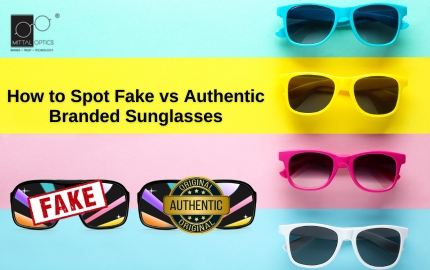Fashion accessories are dominated by sunglasses. They function as more than just a protection against dangerous ultraviolet rays; they also act as a display of personal style and frequently symbolize opulence. Nonetheless, identifying the difference between counterfeit and genuine branded sunglasses is becoming progressively difficult due to fake products proliferating in the market. This guide will assist you in finding the real deal, not a counterfeit, as you sail through the ambiguous world of eyewear.
The Devil’s in the Details
When it is about identifying fake sunglasses, the key factor is attention to detail. Genuine luxury brands are known for their flawless workmanship which can be seen in all parts of their goods. Look carefully at the frame. Designer sunglasses that are real will show clean, clear lines. They won’t have any rough edges or messy construction. The color must be even and not show blotches or differences in shade. If you see glue residue or joints that are not smooth, it’s probably a fake item.
Check the hinges carefully. Sunglasses of good quality usually have detailed and well-made hinges that work smoothly and feel solid. However, counterfeit sunglasses might possess weak or incorrectly aligned hinges which give a loose or sticky sensation when one opens and closes the arms.
The Lens Test
The lenses are one spot where many counterfeiters try to save money, and it is frequently the place where you can identify a fake most simply. Genuine branded sunglasses employ top-grade lenses that provide excellent clear vision and frequently include advanced features such as polarization or photochromic performance. To check the lenses, take the sunglasses at an arm’s length from your eyes and observe a straight line like a door or window edge. Move the glasses slowly up and down. If the line seems to wiggle or distort, chances are you are looking at fake lenses.
Also, it’s common for designer brands to add anti-reflecting coverings on their lenses. When you move authentic sunglasses in front of a light source, they will show a slight reflection that is usually colored. Fake glasses might not have this coating at all or possess one of low quality which looks too bright and inconsistent.
Branding and Packaging
Luxury eyewear brands pay great attention to their branding details. Look closely at the logo on the sunglasses. Real logos often have precise etching or embossing, while fake ones may be painted on and seem unclear or not aligned correctly. Check for small details that are frequently missed by counterfeiters, such as the trademark symbol or registered trademark symbol.
The packaging might tell you too. Real designer sunglasses are packed in good-quality cases that have correct branding, and they sometimes come with cards of authenticity, cleaning clothes or detailed information about the product inside them (like serial number). Counterfeit goods could be packed into weak cases where printing is not clear or missing some parts like accessories.
The Price Point Paradox
Although we may believe that an unusually low price is the simplest way to identify a fake, the truth is more intricate. Some counterfeiters have developed skills in setting their prices just below retail to not raise suspicion. On the other side, dishonest sellers might list fakes at full retail value so they can persuade buyers about their authenticity.
Instead of just thinking about money, think about where you are buying from. The best places to buy are authorized retailers and the brand’s official website. Watch out for deals that look too good, particularly if they come from online marketplaces or street vendors who are not familiar to you.
The Tech-Savvy Approach
In recent times, several luxury eyewear brands are using technology against fake production. Some are employing one-of-a-kind serial numbers that can be checked on the brand’s website. Other brands have started to use blockchain technology for making a clear and unchangeable recording of each product’s path from creating it until selling it.
Trust Your Instincts
In the end, trust your feelings when identifying fake sunglasses. If something seems wrong with the item or how you bought it, then it likely is not genuine. High-end luxury brands put much effort into ensuring superior quality and excellent service for customers. If you encounter bad customer service, unclear responses to your inquiries, or a general feeling of discomfort, it is better to leave.
When you add up all these tactics – looking at details, checking quality, verifying branding and using authentication tools – you will have a good set of methods for telling real designer sunglasses apart from fake ones. Always keep in mind that buying genuine eyewear is not just about fashion; it’s also about safeguarding your eyes with correctly made lenses as well as encouraging the invention and skill of real brands.

